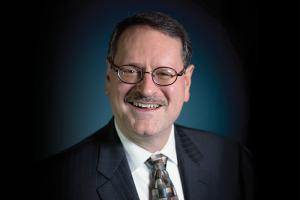President’s Award winner touts energy reduction

The Larry Newlands File
CV
- Director of energy management at Memorial Hermann Health System in Houston (2008-present).
- Engineering manager at Hines Property Management; Williams Tower, Bank of America Center, One and Two Shell Plaza in Houston (1985-2008).
Accomplishments
- Certified energy manager (CEM), Association of Energy Engineers (AEE).
- Certified energy procurement professional (CEP), AEE.
- ENERGY STAR® Partner of the Year for Memorial Hermann Health System: Energy Management (2012-2013) and Sustained Excellence (2014-2023).
- Recertified more than 146 Memorial Hermann hospitals and medical office buildings in ENERGY STAR Portfolio Manager.
- Documented more than $187 million in cost avoidance due to utility benchmarking over the past 15 years.
- Secured more than 50 ASHE Energy to Care® and Sustained Excellence awards for Memorial Hermann facilities.
Larry Newlands, CEM, CEP, the recipient of the American Society for Health Care Engineering’s (ASHE’s) 2025 President’s Award, discusses his career in energy management and the value of loving one’s work in this HFM interview.
How does it feel to win this year’s ASHE President’s Award?
I feel very privileged and honored — surprised and shocked, to be honest. It’s a very humbling experience to be presented with such a prestigious award. I looked at the ASHE website for a list of other members who had previously received the President’s Award as soon as I found out; seeing the names of all the winners over the last 10 or 15 years, I had to ask myself how in the world I should be considered deserving to be listed among them.
How did you first take an interest in building optimization and energy management?
About 40 years ago, I was hired as a stationary engineer working for a property management company that mainly managed and operated high-rise office buildings and went on to work as a facilities manager at a number of prestigious high-rise facilities. During that time, I learned about the proper operation, maintenance and efficiency practices of building equipment and systems. I really enjoyed the energy efficiency side of operations.
When did you transition into working in health care facilities? How is your work different in hospitals than in other types of buildings?
In 2008, I became the facilities director of a small hospital in the Memorial Hermann Health System in Houston, where I applied the principles I had learned from operating office buildings. I quickly realized that hospitals operate quite differently than high-rise office buildings: more rules and regulations; different operating characteristics, like hours of operation; more critical, emergency equipment and systems; and the documentation of policies and procedures is much more complicated. Just about everything is different.
I also found that you can optimize heating, ventilating and air-conditioning (HVAC) systems, along with lighting, among others, to reduce the utility costs of a facility by more than $100,000 per year, or about a dollar per square foot, and track the results on a simple spreadsheet. When I first did this, it must have caught a few people’s attention because I was asked if I could do the same thing at some of the other Memorial Hermann hospital facilities.
You played a key role in originating what is now called the ASHE Energy to Care® Chapter Challenge. What’s the story behind that first challenge?
After recording all the Memorial Hermann hospitals’ utility data on a spreadsheet, I remember [2025 ASHE President and Memorial Hermann Vice President of Facilities Engineering Services] Michael Hatton asked me, “Are these results good?” I replied, “This is great — we now know our energy use and cost per square foot!” Michael then said, “No, is this good, as in, how do these numbers compare to other facilities?” I said I didn’t know. We then benchmarked all the facilities in the system in ENERGY STAR® Portfolio Manager. At that point, we saw how poorly we were really performing. Since then, Memorial Hermann has improved our overall performance significantly: 10 of the system’s 11 hospital campuses, plus nine medical office buildings, are ENERGY STAR certified, totaling more than 146 ENERGY STAR certifications. Most of the hospitals are in the upper 90 percentile, and three have a score between 99 and 100 each year. Memorial Hermann also has been recognized as an ENERGY STAR Partner of the Year for the past 12 years.
We wanted to share our success and include others, so we started the Texas Association of Healthcare Facilities Management (TAHFM) Energy Roundup challenge. Region 7 loves a good contest! The health care systems participating in the TAHFM Energy Roundup included Memorial Hermann, Texas Children’s, Baylor Scott and White, Christus Health, Midland Memorial and many others. We had so much fun and reduced utilities across the portfolio, with the results bearing out over the next few years.
After that first roundup, Mike Hatton asked, “So, what’s next?” I suggested that TAHFM challenge the Ohio chapter to an interstate Energy Roundup challenge. In 2015, we sent a challenge letter to the Ohio Society for Health Care Facilities Management, asking them, “What’s a buckeye, anyway?” That got their attention! They responded by giving us the history of the Ohio State University mascot and thanking Texas for providing the backdrop for the college football championship playoff game the previous year, which Ohio State won. TAHFM had the last laugh, though, because we won the Energy Roundup challenge! And with that, the Energy to Care Chapter Challenge was born. The challenge has grown since then; as of 2025, 18 ASHE Chapters are now competing in the challenge.
How have you been able to share what you’ve learned about energy benchmarking and reduction strategies with others in the field?
We’re always happy to share our story with all who are interested, and over the years, we have discussed many of these ideas and lessons learned as posts on the TAHFM website and at various ASHE events and conferences. New ideas about better ways to manage energy are coming out all the time. We also keep finding that we still need to focus on the basics, like running override points reports and points-of-failure lists, minimizing airflow and controlling temperature after hours and weekends, managing air handler static pressure and developing discharge temperature reset strategies. We also understand that as buildings are getting older, we need to pay closer attention to what’s above the ceiling with variable air volume box operation to minimize overcooling and reheat.
How has your involvement with ASHE impacted your career?
I’ve learned as I’ve gone along, and ASHE has been instrumental in furthering my education and understanding. The greatest impact to me has come from the influential individuals who have kept me motivated, inspired and encouraged, especially when I wasn’t sure I was doing the right thing. I think it’s important I mention some of those individuals by name: Michael Hatton, Mark Kenneday, Terry Scott, Antonio Suarez, Skanda V. Skandaverl, Dave Lockhart, Burt Gumeringer and Marty Lanning, just to name a few.
Many of the hospital facilities directors I work with every day are great people. That’s one of the main reasons I look forward to going to work — I have fun with these people every day. I feel lucky; not everyone gets to do something they really, really love.
What advice would you offer to someone looking to take meaningful steps in energy management in their facilities?
Start with the basics, and don’t get overwhelmed. Find a way to track your progress, success and failure alike. If you can’t prove it, it didn’t happen. Don’t be afraid to ask for help, and don’t let your ego get in your way. Many people would love to help you. ASHE has plenty of resources to get you started, like the Energy to Care Program. Plugging into your regional ASHE Chapter is a great way to meet people who can help.
Landon Hegedus is editor of Health Facilities Management magazine.




